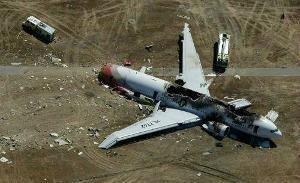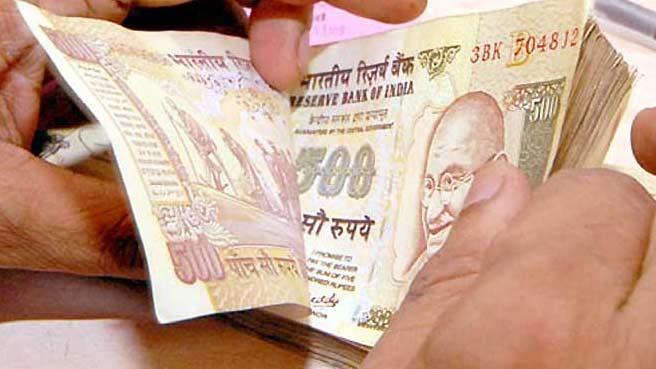July 8, 2013
SAN FRANCISCO: The Asiana Airlines jet that crashed at San Francisco airport was traveling much slower than recommended and a pilot asked to abort the landing moments before the plane smashed into the ground, US investigators said Sunday.

July 8, 2013
SAN FRANCISCO: The Asiana Airlines jet that crashed at San Francisco airport was traveling much slower than recommended and a pilot asked to abort the landing moments before the plane smashed into the ground, US investigators said Sunday.

The flight data recorder also showed that the Boeing 777 airliner received a warning that its engines were likely to stall as it approached the runway, where it later burst into flames killing two people and injuring 182 others.
The request to abort the landing was captured on the cockpit voice recorder 1.5 seconds before the plane crashed, said National Transportation Safety Board chairwoman Deborah Hersman, who is leading the crash probe.
Her announcement came minutes after a video obtained by CNN confirmed that the aircraft, carrying more than 300 people, clipped a seawall short of the airport and skidded on its belly on to the runway before flipping over.
The footage showed the nose was up with the rear of the plane hitting the ground first, before it rolled on to the concrete, bounced upward and then spun round 180 degrees.
The NTSB team in San Francisco is examining the wreckage of the plane. The two passengers who died were teenage Chinese girls.
Asked about the speed at which the plane was traveling, Hersman stressed that it was well below the target of 137 knots.
"We have to take another look at the raw data and corroborate it with radar and air traffic information to make sure we have a very precise speed. But again, we are not talking about a few knots here or there. We're talking about a significant amount of speed below 137," she said.
The crash sheared off the plane's landing gear and ripped the tail off the fuselage. Large portions of the plane's body were burned out in the massive fire that erupted.
Earlier Sunday, Yoon Young-Doo, the CEO of Asiana Airlines, based in Seoul, said "currently we understand that there are no engine or mechanical problems" with the plane, which was bought in 2006.
NTSB chair Hersman refused to elaborate on whether the flight crew was to blame, noting that the pilots would be interviewed and stressing that it was day one of the probe.
However she said the plane's low speed triggered an automatic device called a "stick shaker" which warns pilots that a plane is about to stall. The warning came four seconds before the crash — 2.5 seconds before one of the pilots tried to abort the landing.
Hersman said: "There was a call out for a go around from one of the crew at 1.5 seconds prior to impact. And the call out is a — is communication between the crew that they want to go around, that means they want to not land but apply power and go around and try to land again."
Asiana Flight 214 originated in Shanghai, and had 307 people on board — 291 passengers and 16 crew — after it stopped to pick up passengers in Seoul.
Many of the injured were still in critical condition or unconscious, the San Francisco General Hospital said in a press briefing.
Doctors saw "large amounts of abdominal injuries, a huge amount of spine fracture, some of which include paralysis, and head trauma and multiple type of orthopedic injuries," Margaret Knudson, interim surgery chief at the hospital, told reporters.
Some 15 or 16 had yet to regain consciousness, she said, adding that "some of our patients have been operated on twice already, and there's going to be many many more surgeries to come still."
Other patients had been sent to different area hospitals.
The plane was being flown by experienced pilots, and there was no emergency warning ahead of the crash, Asiana's Yoon said, adding "our pilots strictly comply with aviation rules."
"Please accept my deepest apology," the CEO added, bowing in front of TV cameras at a press conference in Seoul.
A four-member South Korean government team was also heading to inspect the site of the accident, officials in Seoul said.
Aboard the flight were 141 Chinese nationals, 77 South Koreans, 64 Americans, one Japanese, three Indians, three Canadians, one French, one Vietnamese and three others of unidentified nationality. There were also 16 crew members, according to Asiana.
San Francisco International Airport was closed after the crash but operating normally Sunday.
In total, 123 people aboard the flight escaped unharmed, US officials said.
The twin-engine 777 aircraft is one of the world's most popular long-distance planes, often used for flights of 12 hours or more, from one continent to another.
It was the first fatal crash involving an Asiana passenger plane since June 1993, when a Boeing 737 operated by the carrier crashed into a mountain in South Korea, killing 68.
Courtesy: AFP
















































































































